Welcome to the 2021 edition of Quill & Pad’s early Grand Prix d’Horlogerie de Genève predictions in which the team picks favorites and explains why.
The panelists are:
Elizabeth Doerr (ED), co-founder and editor-in-chief
Ian Skellern (IS), co-founder and technical director
Joshua Munchow (JM), resident nerd writer
GaryG (GG), resident collector
Martin Green (MG), resident gentleman
The Mechanical Exception category features watches with a special mechanism such as an innovative or sophisticated display, an automaton, a striking or any other acoustic function, a special escapement, a belt-driven movement, or any other original and/or exceptional horological concept.
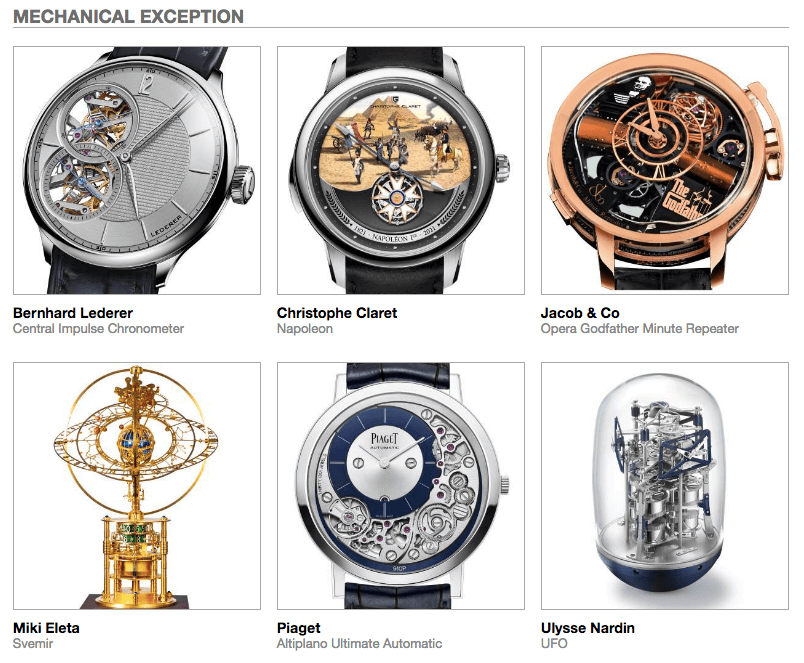
Nominated Mechanical Exception watches in the 2021 GPHG
MG: This is a battle of the beasts as the watches in this category usually pack hefty horological punches. This year is not different, although I am surprised to see two clocks, but even those are of an exceptionally high caliber. I do wonder if they don’t need a category of their own as they for sure deserve one, given that they are increasingly populating the haute horlogerie scene. Or perhaps Jaeger-LeCoultre should just enter an Atmos in the Iconic category!
ED: If we thought comparing apples and oranges would be tough, Martin, how about comparing apples with different cuts of beef? That’s what it’s like to see wristwatches and clocks in this category together.
JM: What an incredible breath of fresh air to have the Mechanical Exception category have not one but two clocks included in the nominated pieces! But in the very same breath I have to ask: according to almost every line in the rules, the competition specifically focuses on watches, so was this a previously untested avenue of entry or is the competition expanding what it wants to consider? The competition is named the Grand Prix d’Horlogerie de Geneve, so it theoretically should cover all horological creations, but when you read all the rules and literature, it is clear the intent is for watches.
I have no qualms with including clocks, but given the manufacturing and engineering constraints that differ wildly between a machine for your wrist and something that could possibly take up an entire table, it would seem prudent to have a separate category for non-wristwatch horology. I’m super excited to hear everyone’s takes on this turn of events and to see what wins because I am definitely much less confident in what will take the prize with this category.
ED: So what do we have here? A watch with an innovative escapement style, two minute repeaters, an ultra-thin timepiece, and two clocks: I’m quite sure that the GPHG has never seen such a wildly different bunch in one category – not even this category, which is kind of a fun free-for-all in terms of mechanical creativity.
IS: What a selection! The category rules state that it is for “watches,” but we have two clocks; my top watch here isn’t my predicted winner; and what I thought would take my top spot didn’t. Hang onto your hats, this will be a wild ride.
Bernhard Lederer Central Impulse Chronometer
ED: This year during Geneva Watch Days we were introduced to the new and improved version of the Central Impulse Chronometer that Bernhard Lederer debuted in 2020. What’s new and improved are the dial visuals – and, yes, these are greatly improved! The rest of the watch is basically the same as last year’s submission.
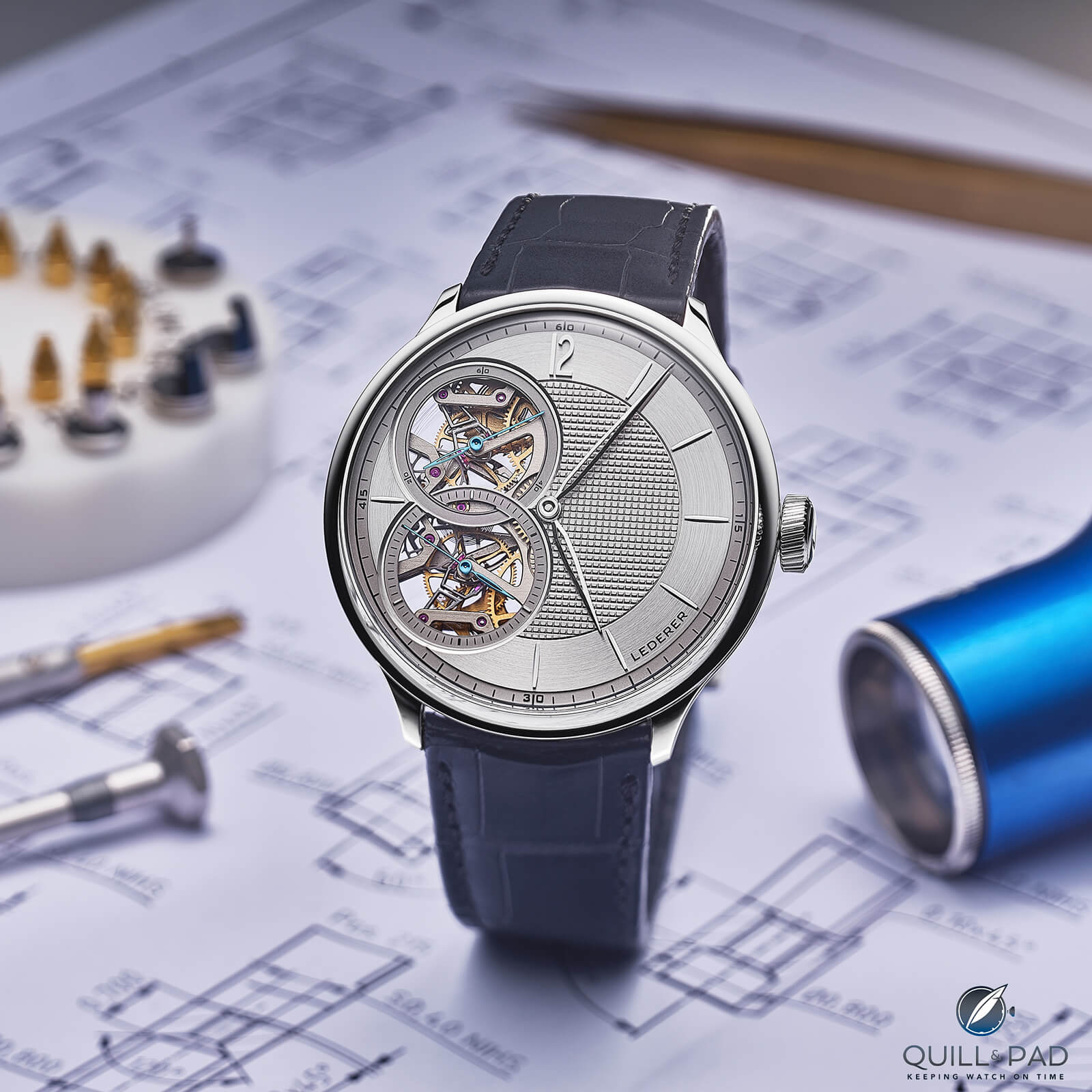
Bernhard Lederer Central Impulse Chronometer
I must point out something here too: the GPHG description of this watch states that, “Caliber 9012 is certified as a chronometer by the Besançon Observatory and COSC.” The two examples of this watch that we saw in Geneva were not yet certified because, as Lederer told us, they do not yet have the equipment to capture the timing of the dual escapements.
Once that is sorted out, I believe this will be one hell of a watch and could rightfully win a category like this. But until I see that it delivers what it promises, I am going to remain a bit reticent about that call.
MG: Yes, it is 44 mm, and for that I should discard it, but I can’t. Bernhard Lederer simply made such an amazing and delightful watch.
ED: We had the chance to try this on, Martin, and I did not find it too big.
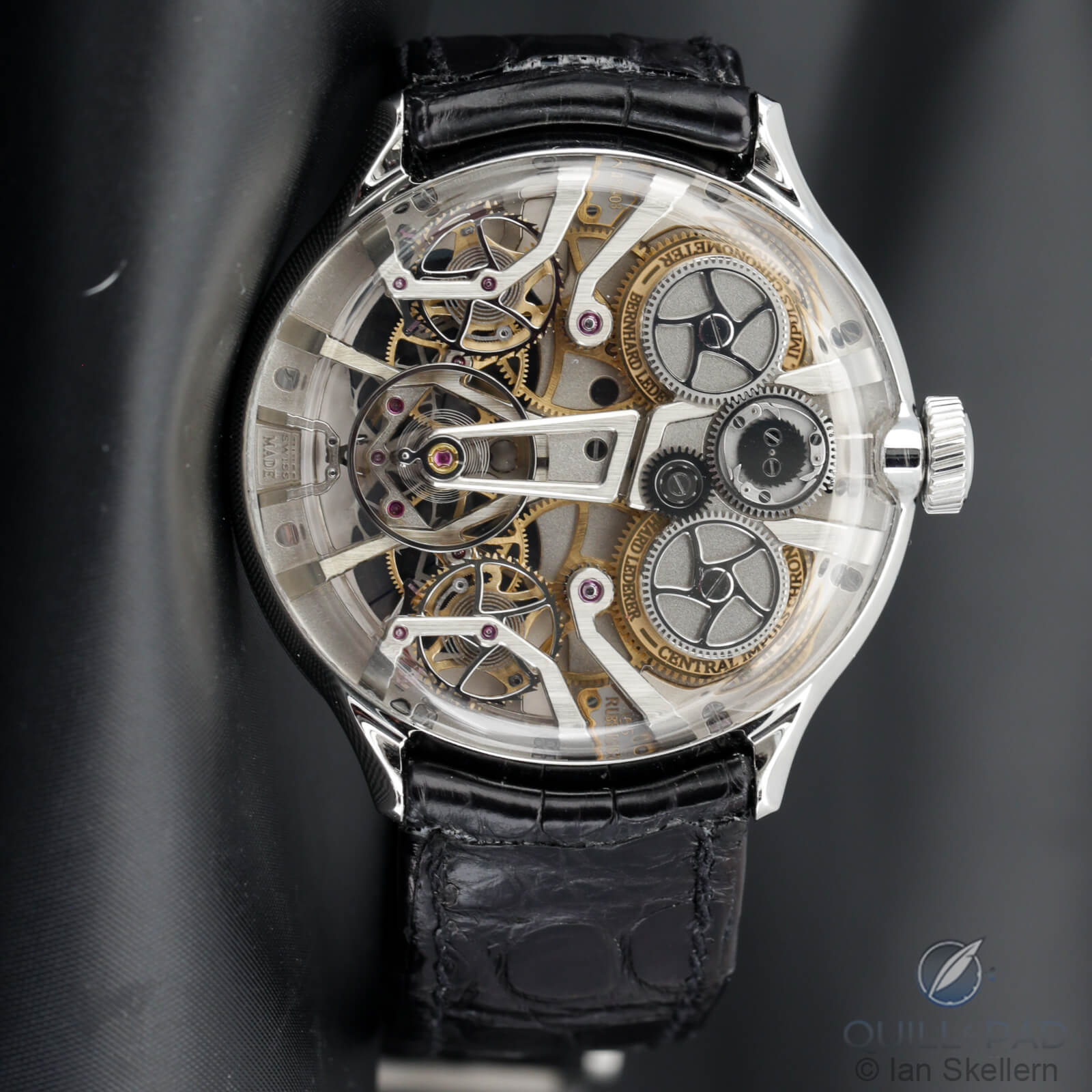
The incredible movement visible through the display back of the Bernhard Lederer Central Impulse Chronometer
MG: What stands out most is not only its mechanical excellence, but also how well the movement is now incorporated into the design. In particular I love how the two cutouts in the dial intertwine while the rest is kept very sober. The back is a different story with a beautiful view to the double gear train, both remontoires, and the peerless escapement. It all gives me goosebumps, which makes it my predicted winner in this category.
GG: Oh, how I wanted to pick the Lederer! As I said when this reference was originally nominated last year it’s gorgeous on the movement side, and the technical wizardry built into the escape mechanism is otherworldly. And this year’s incarnation is so greatly improved in terms of dial aesthetics that it almost seems like an entirely different watch. Sadly, it’s not, but it’s certainly a significant step up in coherence and appeal from last year’s nominated version.
JM: It is extremely hard to argue against this watch getting recognition simply due to the incredibly complex and detailed engineering that had to go into this movement. It has been years in the making, features a unique escapement, and it will be chronometer certified, which is actually difficult for a watch like this. The movement is a work of art, and the dial side has been greatly improved since the original version launched. Additionally, the entire case back is actually a giant machined piece of sapphire crystal; there is no hiding the work from the rear.
I think this watch has the greatest chance for an independent to win this category, but it has a lot of competition. I’d like to see it get recognized, but I’m playing it safe and picking it as a runner-up (with a great chance of taking the prize).
IS: The Bernhard Lederer Central Impulse Chronometer is my pick for the best wristwatch in this category. I love the movement, the complication, and the execution, even if I mark it down a few points for having been entered (prematurely, in my opinion) last year. While it is my top watch, the Central Impulse Chronometer isn’t my pick for winner as I think there are two clocks ahead of it.
Further reading: Bernhard Lederer Central Impulse Chronometer*: A Superlative Watch But Is It Really A Chronometer?
Quick Facts Bernhard Lederer Central Impulse Chronometer
Case: 44 x 12.2 mm, white gold
Movement: manual winding Caliber 9012 with dual gear train with dual 10-second remontoirs and natural escapements, 21,600 vph/3 Hz frequency, 38-hour power reserve
Functions: hours, minutes, seconds
Limitation: 50 pieces
Price: CHF 137,850 Swiss francs
Christophe Claret Napoleon
MG: A minute repeater with tourbillon and jaquemarts is always one to whet the appetite. For this watch, Claret picked the Battle of the Pyramids fought on July 21, 1798 in Egypt, in which Napoleon led the French forces to a decisive victory against the Ottoman empire. Not my choice of scene, but perhaps you have to be French to appreciate it. While this was a decisive victory, the French forces were not so lucky a few days later when British Admiral Horatio Nelson destroyed the French fleet anchored off the Egyptian coast, effectively trapping Napoleon and 35,000 soldiers in Egypt.
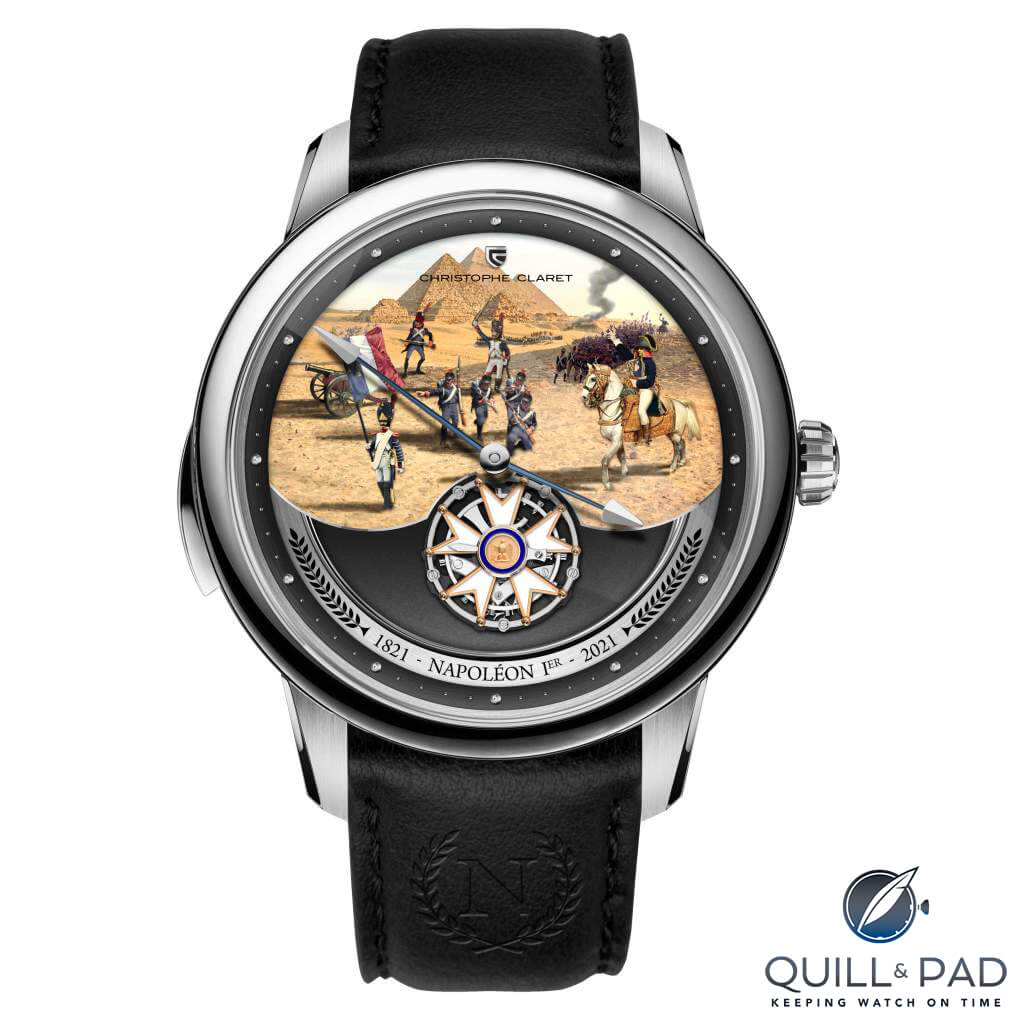
Christophe Claret Napoleon
While well executed I feel that the scene set with these watches is very important, and this is simply not my cup of tea. Also, with a diameter of 47 mm this watch is enormous in a way that has completely fallen out of vogue. I do wonder why it is so large as the movement is not that big in diameter. The good thing is that Claret opted for a titanium case, ensuring that it sounds better than if a precious metal had been chosen.
ED: This watch looks to me like it was left over from the Rolf Schnyder era of Ulysse Nardin. UN always commissioned its jaquemarts minute repeaters from Claret, and these watches often had scenes like this playing out on the dial. Hannibal, anyone? The resemblance is pretty striking . . .
Not to knock the serious watchmaking here, but it is just no longer contemporary.
JM: Right off the bat you have a minute repeater with Westminster chime, dial-side automata, and a flying tourbillon, so one of the most complicated pieces in the category (though it is beat by one other piece). And yet, since I can’t hear it, I can’t claim to know if it lives up to its potential.
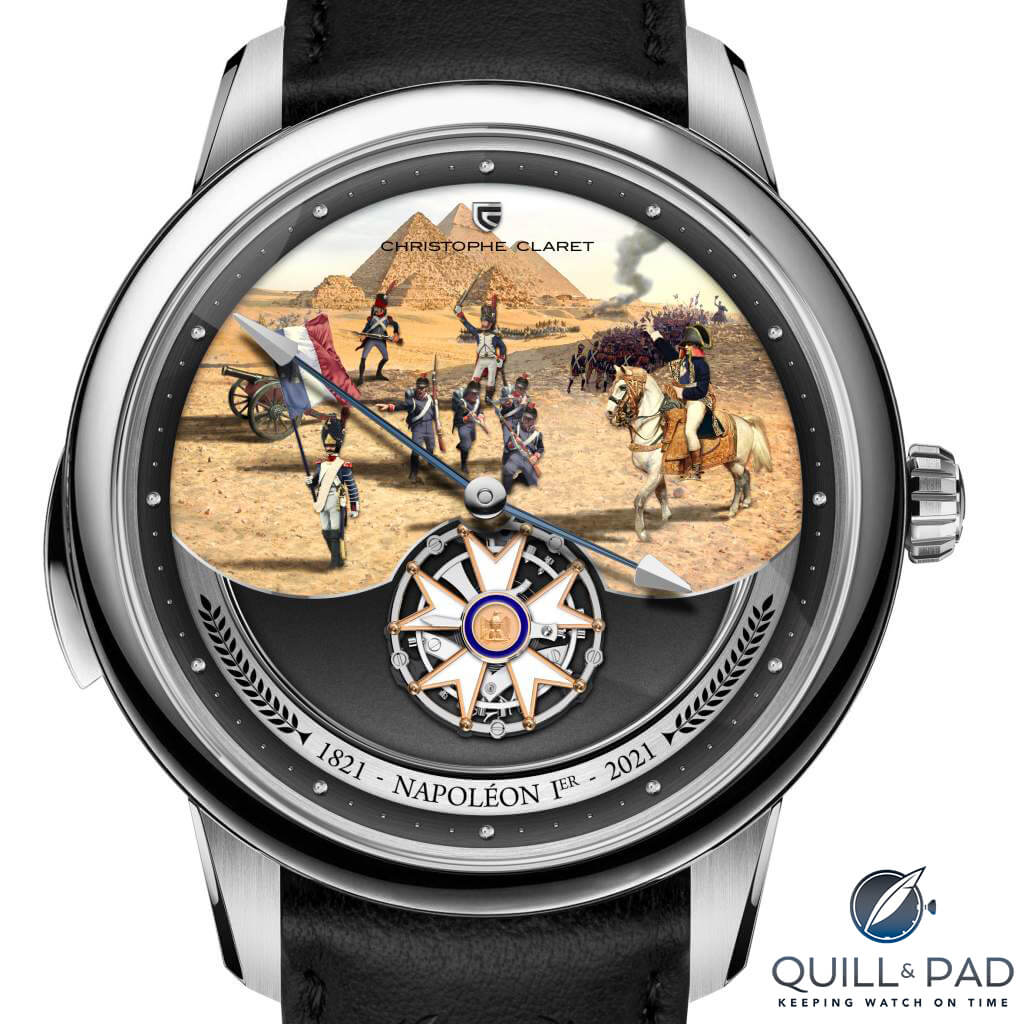
Christophe Claret Napoleon
The miniature painting and automata on the dial are highly impressive, but the flip side of the coin is that it could be aesthetically polarizing for some of the jury. In the Mechanical Exception category price should play no role, so it doesn’t matter that it is the most expensive watch in the group, but it also is a fairly large watch in diameter and thickness, and that could be something that turns some off. But there are also two clocks in this category this year, so size may matter less than simply being a watch.
I think this has a good shot, but it may also be less broadly appealing to the jury. So I’m really on the fence with the Napoleon and don’t feel confident giving it the nod.
GG: What to say about the Christophe Claret Napoleon? It’s a Claret, so I’m sure it sounds great. But the prospect of seeing oddly photorealistic renderings of French soldiers cavorting about in front of the Pyramids in time with the watch’s chiming is just too much for me.
IS: The Christophe Claret Napoleon is certainly mechanically exceptional, but I think the caliber has been around too long, a painting of a military scene is out of step with the times (and not everyone, including many French, think that Napoleon is a hero), at 47 mm the case size is also no longer contemporary, and the movement is far too small for the case. I never thought I’d see a minute repeater, flying tourbillon with jaquemarts and think, “ho hum.”
Quick Facts Christophe Claret Napoleon
Case: 47 x 16.78 mm, titanium
Movement: manual-winding caliber with 60-second flying tourbillon, 21,600 vph/3 Hz frequency, 60-hour power reserve
Functions: hours, minutes; Westminster chime minute repeater with jacquemarts automata
Limitation: 8 pieces
Price: 635,500 Swiss francs
Jacob & Co Opera Godfather Minute Repeater
MG: Would it help if the GPHG only allowed entirely new watches to enter in certain categories in their year of launch? It might make the competition a bit more focused.
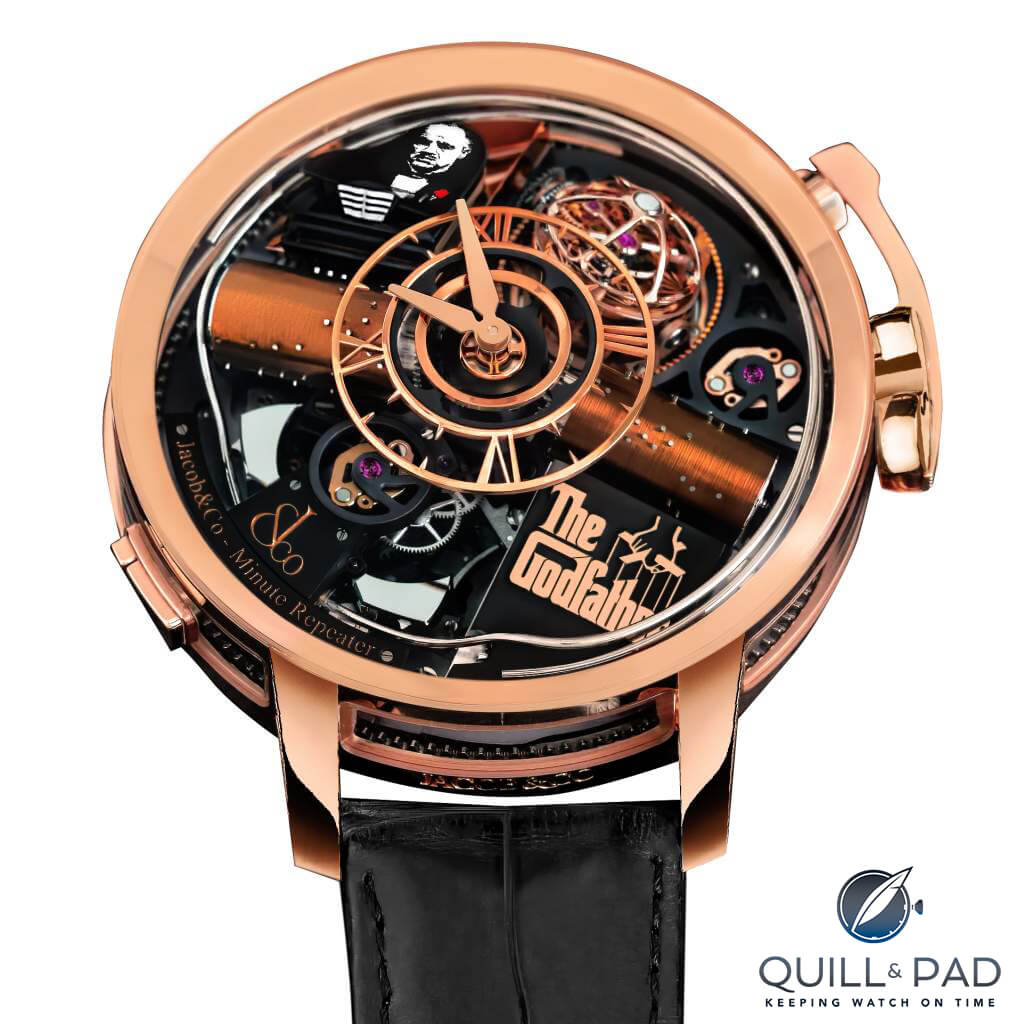
Jacob & Co Opera Godfather Minute Repeater
The Jacob & Co Opera Godfather Minute Repeater was initially launched in 2018 and was different from this model only in that its dial was in the middle of the watch. At the time of that watch’s introduction, I wasn’t impressed by the watch’s sound as the flow was off, but I was shown it at Baselworld, and complex watches like this suffer greatly from being handled by so many people and played constantly during a fair.
This might be the perfect watch for those who are really into The Godfather and have similar funds. If not, “leave the watch, take the cannoli.”
ED: I found this watch entirely kitsch back in 2018, and I find it to be that today as well. The size, the theme, the licensed Godfather music . . . all a big turnoff for me.
That opinion does not touch the fact that this is a tiny mechanical marvel, but I can’t in my wildest dreams imagine anyone actually wearing it. Except perhaps Marlon Brando. And he’s no longer here.
GG: As William F. Buckley famously said about Hunter S. Thompson’s Fear and Loathing in Las Vegas, “It inspires the same sort of admiration one might feel for a streaker at Queen Victoria’s funeral.” So it is with the Jacob & Co Opera Godfather Minute Repeater.
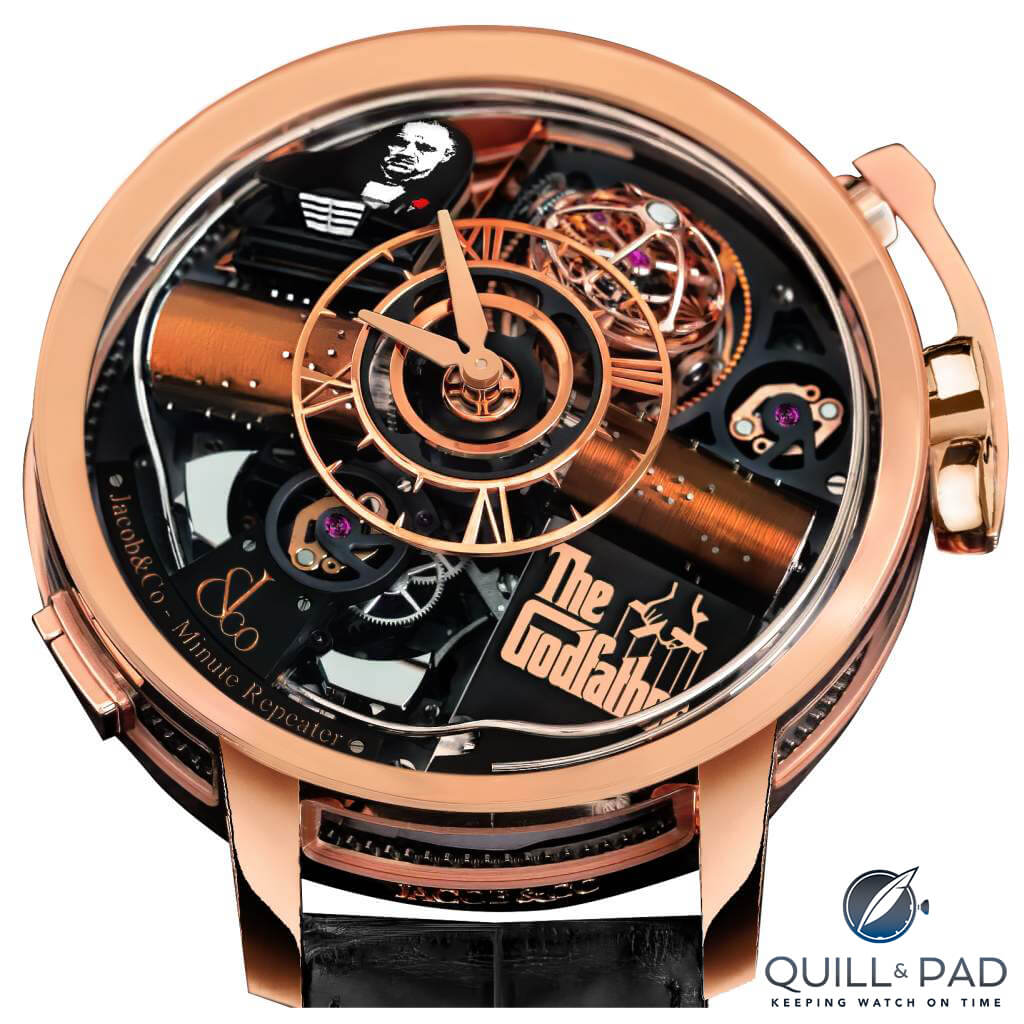
Jacob & Co Opera Godfather Minute Repeater
JM: This is the most complicated watch in the category with a triple-axis tourbillon, a minute repeater, and a twin-comb music box playing the theme from The Godfather. It also is so entirely kitsch that the intended audience is either a college kid that got rich off cryptocurrency, an actual Mafioso, or Dan Bilzerian.
The watch is also massive and feels like it will get shared around message boards on Reddit and 4Chan by type of people who would drool over it. I’m being harsh, but the Godfather aesthetic feels like Invicta for billionaires (I know, shots fired). I don’t often trash talk watches, and Jacob & Co makes some truly incredible creations, but I have a sense this was requested by a client and should have stopped at a one-off instead of being an 18-piece limited edition. But knowing how the world is, it’ll sell anyway.
Long story short, I appreciate the horology and the effort, but wish this watch wasn’t a part of this category.
IS: The Jacob & Co Opera Godfather Minute Repeater inspires the same feeling in me as the Christophe Claret Napoleon: ho hum. Mechanically superb, but the kitsch Godfather theme just kills the watch for me. And as good as it is, the model is now a few years old and I’m looking for real innovation to win here, not (questionable) cosmetic changes.
Quick Facts Jacob & Co Opera Godfather Minute Repeater
Case: 49 x 23 mm, pink gold
Movement: manually wound Caliber JCFM07 with triple-axis tourbillon and music box with double combs, 3 Hz/21,600 vph frequency, 44-hour power reserve; movement dimensions: 44.3 x 17.09 mm; 758 components
Functions: hours, minutes, seconds; minute repeater, music box
Limitation: 18 pieces
Price: 540,000 Swiss francs
Miki Eleta Svemir
GG: Okay, let’s just save a lot of time and give Miki Eleta the trophy right now, shall we? It’s really cool to see clocks as well as watches eligible in the Mechanical Exception category, and Eleta’s Svemir is a corker. The list of complications is as long as your arm, but at the top of the list is that this marvel simultaneously displays interpretations of the heavens based on the heliocentric and archaic geocentric models. Heck, there’s everything except a flat earth in there! I will be very keen to see this piece in person and imagine that I will be totally gobsmacked.
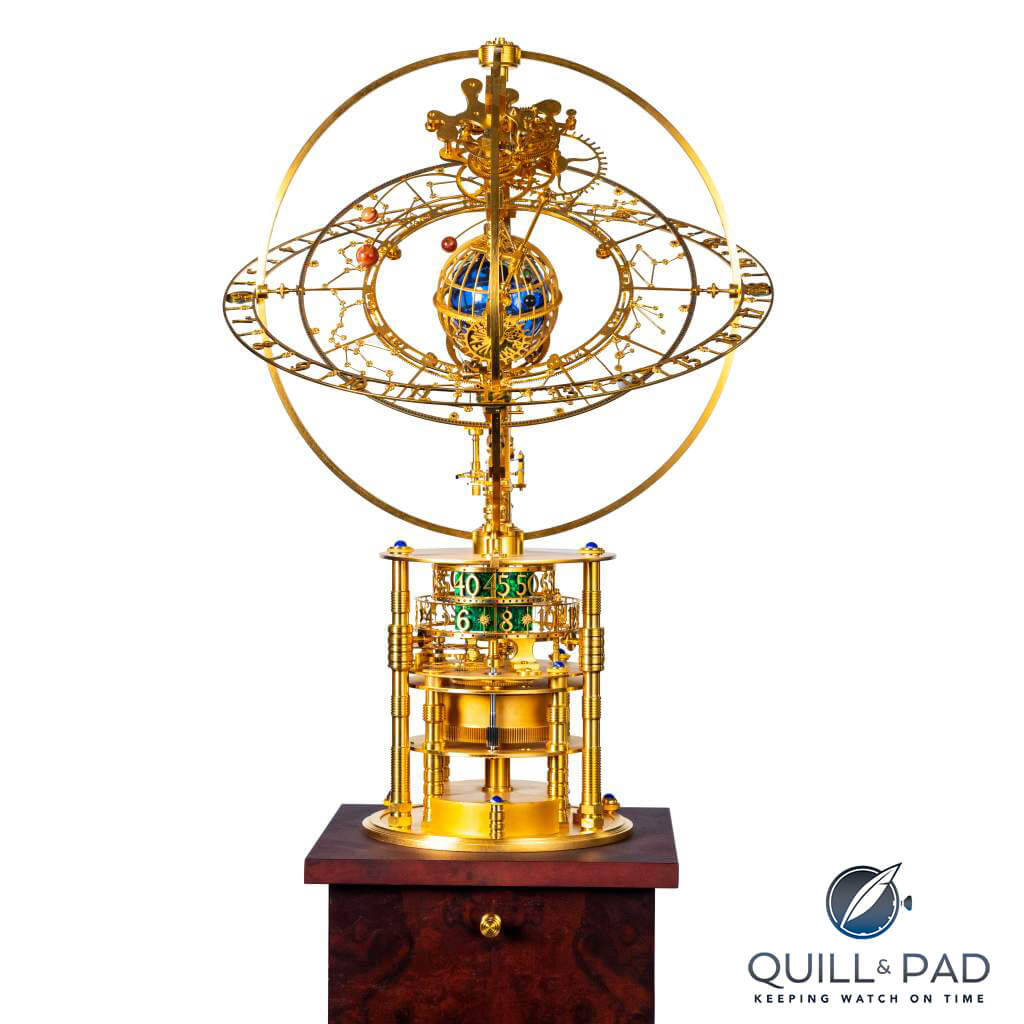
Miki Eleta Svemir
IS: I could copy/paste your comments for mine Gary: the Miki Eleta Svemir blows the rest of competition here away, and I was expecting to cast my vote for the Ulysse Nardin UFO. I’m ashamed to say that I had to look geocentric and heliocentric time up (geocentric has the earth at the center of the universe, while heliocentric has the sun at the center).
Miki Eleta is a simply a genius clockmaker and, while I’d like to see clocks in their own category, there’s no doubt that until they get that these two clocks fully deserve to be here. The Miki Eleta Svemir is mechanical exception at its very best.
ED: Well, well, well. This is the first time that clocks have shown up at the GPHG, and I’m not sure that it’s right to put them in a category with wristwatches, even if the two in this category are so exceptional. If you’re going to do this, GPHG Foundation, then I say give clocks their own category!
MG: Miki Eleta is a craftsman like no other, and even if the style of this clock is not your cup of tea, you cannot deny that it is a masterpiece. I like that it comes with a demonstration crank where you can send the planets to hyper speed to dazzle a (private) audience, after which they automatically re-set themselves back to their real-time positions afterward. This type of ingenuity shows the exceptional high quality of this creation.
IS: Agreed, Martin, the hyper drive crank makes a fantastic work of horology even better.
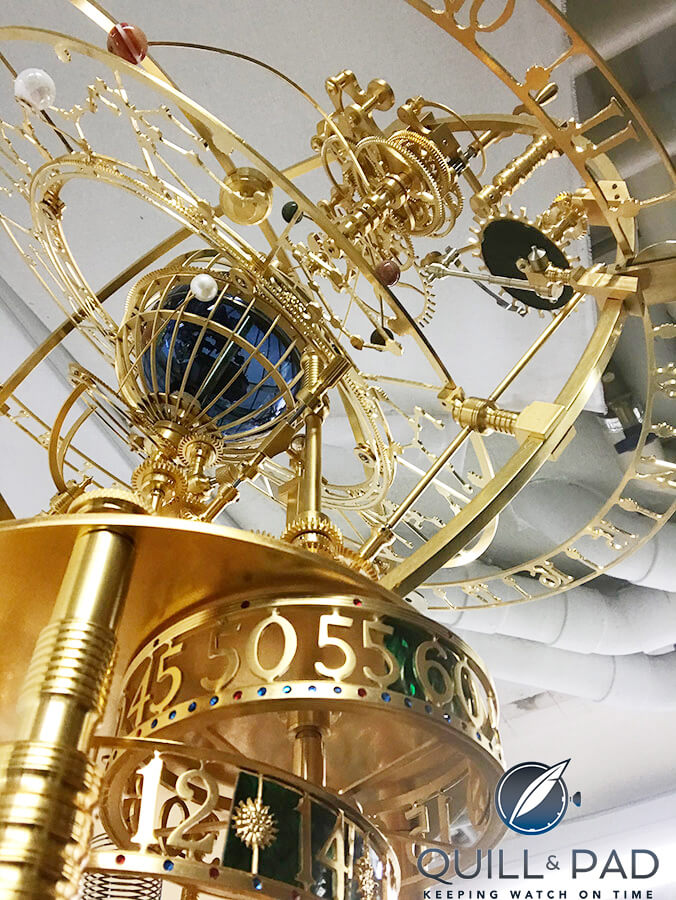
Miki Eleta Svemir
ED: Eleta is my favorite clockmaker, and I have been entirely wowed by his creations in the past, Martin. I love that each of his clocks is a one-off, after which he moves on to his next idea. I love the extreme attention to detail. I love the beautiful decorative details built into each and every clock. And I love that he does every single thing that goes into making this clock himself.
If the GPHG is going to add clocks to this category and the 500-person-strong Academy has voted it into the final six, then this is hands down my category winner.
JM: Miki Eleta is a gem of the industry and the AHCI. He is a gracious man who makes some of the most insanely awesometastic clocks, and the Svemir is a perfect example. It is a true horological wonder with almost 20 indications and two astronomical models. And allows for a manual demonstration of these models via a hand crank along with a memory feature to reset it back to the proper current orientation. It is incredible.
And it is also a clock, a large one at that. This is where I have literally NO idea how the jury will react, and if its members will honestly consider the Svemir to win this category or if they will love it but ultimately vote against it as it is not a watch and just falls so far outside of what we normally see in the GPHG. I honestly would be happiest to see it lose this category and get a special award from the jury for Horological Audacity or something similar.
Quick Facts Miki Eleta Svemir
Case: 330 x 600 mm, gold-plated brass, walnut base
Movement: manually wound movement, 144-hour power reserve, 4,160 vph frequency
Functions: jump hours, minutes; perpetual calendar with date, date, month, year, moon phase, zodiac, seasons, equinoxes, solstices, ecliptic, equation of time; power reserve indication, worldtime, day/night indication, displays of geocentric and heliocentric time
Limitation: one unique piece
Price: 200,000 Swiss francs
Piaget Altiplano Ultimate Automatic
ED: I love the ingenuity of the Altiplano Ultimate; the thinness is absolutely breathtaking. But we have now seen several years’ worth of these, with the Ultimate Concept actually winning the Aiguille d’Or in 2020. I feel that enough extensions in particular in this category is enough.
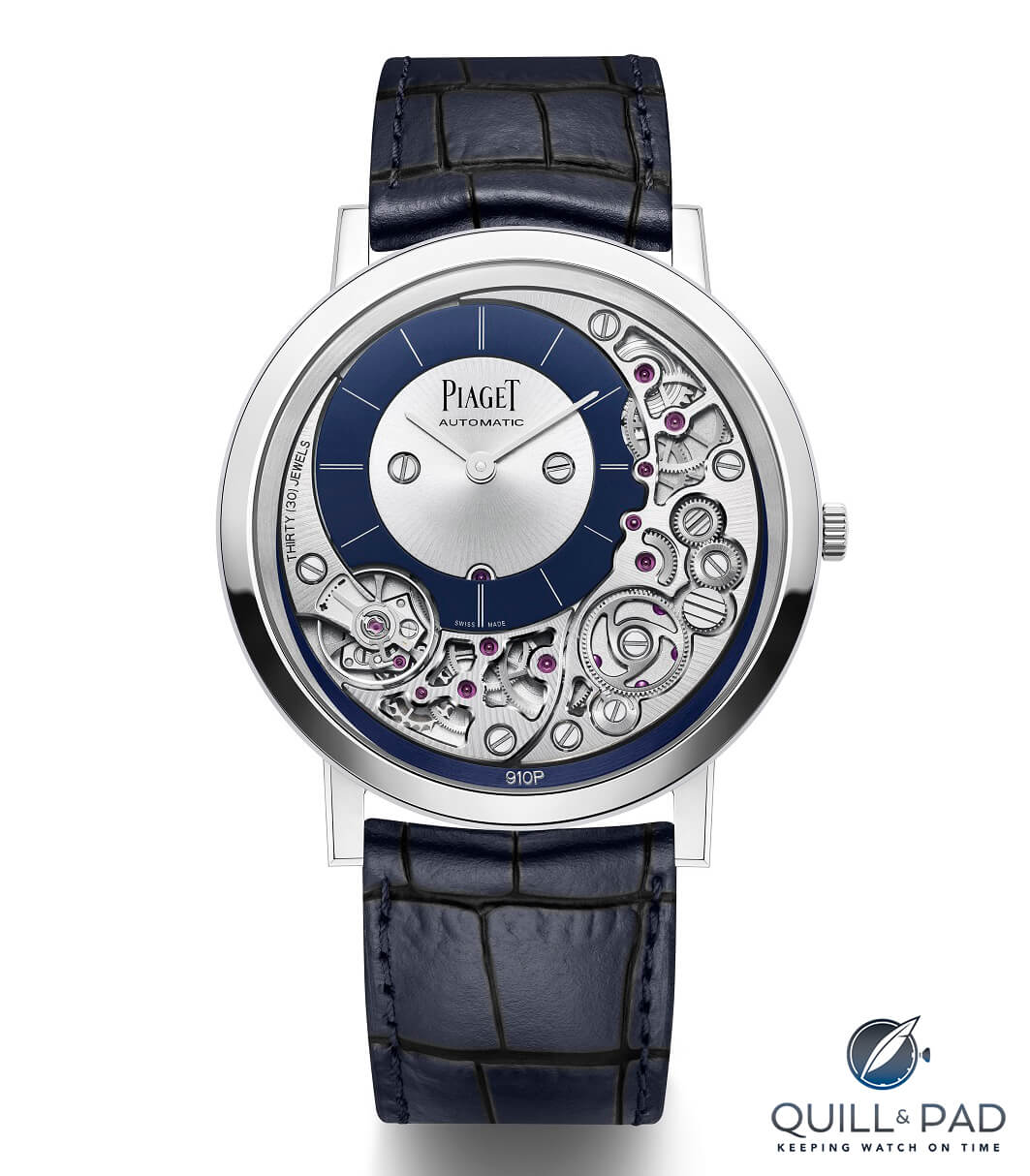
Piaget Altiplano Ultimate Automatic
MG: I was also surprised to see the Piaget Altiplano Ultimate Automatic as an entry in this category, Elizabeth. This watch was already launched in 2018 and was the thinnest automatic watch in the world for a brief few months before Bulgari took over that title with the Octo Finissimo Automatic Tourbillon (see Top 10 Thinnest Mechanical Wristwatches: 8 Modern Record Holders And Their 2 Historic Rivals).
While still a stunning and mechanically imposing watch, it feels too much like old wine in a new bottle.
IS: While the Piaget Altiplano Ultimate Automatic certainly comprises exceptional mechanics, it won the Aiguille d’Or in 2020 so I feel it’s had its place in the spotlight.
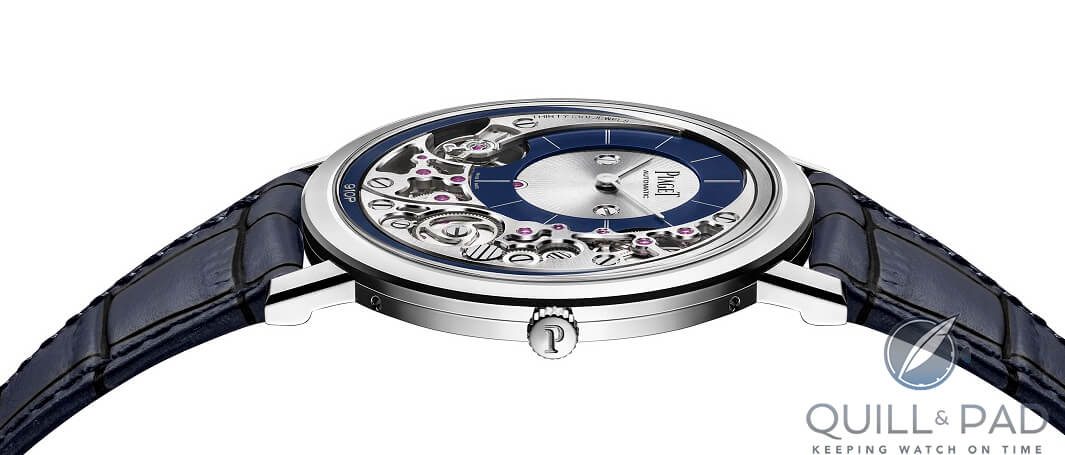
Piaget Altiplano Ultimate Automatic
GG: Piaget comes at us once again with a super-thin Altiplano, this time the Ultimate Automatic. It looks lovely, and I’m sure it’s a technical tour de force, but it loses out to the clocks for me this time around.
JM: If the jury goes for a more established brand, this is the winner for this category. It is a 4.3 millimeter-high automatic wristwatch that is a wonder of micro engineering and was made possible thanks to creative development over a number of years.
It could lose out to Bernhard Lederer, but I think it is equally impressive and deserving of recognition of mechanical exceptionalism. It’s also incredibly affordable when compared to everything else in this category. Only the Ulysse Nardin UFO clock is even comparable in price, and it’s a clock. Everything else is four to 21 times as expensive. As I said with regard to the Claret Napoleon, price shouldn’t play a big part, but that is in relation to docking points for being expensive. Complicated watches can get expensive, that is nothing new, but doing something complicated and still trying to make it competitive in any appreciable way (for high-end watch collectors of course) shouldn’t be overlooked either.
I think there is a good chance of it winning and it is my pick, though I still feel this category is a literal tossup this year!
Further reading:
Piaget Altiplano Ultimate Concept, The World’s Thinnest Watch: Shaving Microns To Make Millionths
Top 10 Thinnest Mechanical Wristwatches: 8 Modern Record Holders And Their 2 Historic Rivals
Quick Facts Piaget Altiplano Ultimate Concept
Case: 41 x 4.3 mm, white gold
Movement: ultra-thin automatic Caliber 910P with peripheral rotor, fused with case, 21,600 vph/3 Hz frequency, 48-hour power reserve
Functions: hours, minutes
Price: 30,300 Swiss francs
Ulysse Nardin UFO
GG: The Ulysse Nardin UFO with its three time zones, rocking-buoy design, and one-year power reserve is no slacker, either. The “driftwood” presentation box is a bit much, but I enjoy both the concept and the execution. If it weren’t for Eleta’s Svemir I’d be seriously considering the UN as my pick.
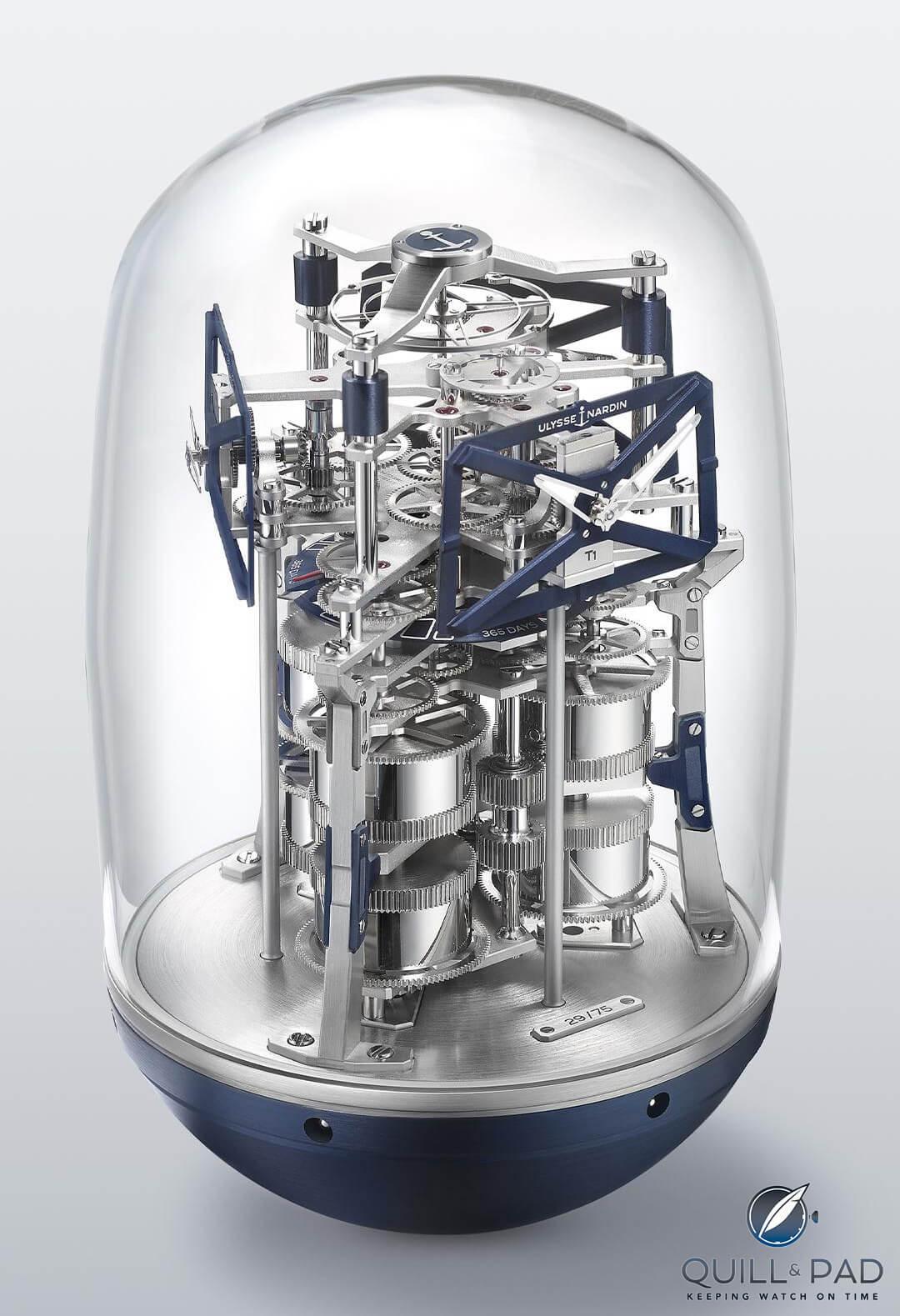
Ulysse Nardin UFO Clock
IS: Again, I could copy/paste your comments, Gary, after seeing (and being blown away by) the Ulysse Nardin UFO at Geneva Watch Days. With its sensational looks and full 12-month power reserve, I thought that the UFO would be my hands-down winner here; however, it’s my runner-up to the even more awesome Miki Eleta Svemir. Clocks rock this category, and the UFO literally rocks (and rolls).
MG: In many ways, a clock makes for a better investment than a watch as it becomes an intricate part of one’s interior design, while watches often enter a rotation. Like MB&F does on a regular basis, Ulysse Nardin worked with L’Epée 1839 to create this, resulting in a stunning clock with three time zones crowned by an extra-large oscillator. While I love it, I feel that the Ulysse Nardin “DNA” in the clock could have been better. Also, you have to remember which of the three is set to which time zone otherwise it becomes confusing very quickly.
ED: Good points all, Martin. This clock is my close runner-up in the category, an ingenious Weeble that wobbles but doesn’t fall down in fantastic marine chronometer tradition. There’s not much that I don’t love about the creativity of this table clock; I just love Eleta’s opus more.

Ulysse Nardin UFO Clock
JM: I love this clock and have since I first saw it. And when I finally spent time with it in Geneva and played around with its wobble, I fell in love with the fun even more. It is a great time piece, made in collaboration with L’Epée with an awesome hand-blown glass dome, and I know it was received amazingly well. But in this category, with everything it’s up against, I really don’t know if it is the best timepiece, let alone the most mechanically exceptional clock in the category. Plus, the jury still may not reward the clocks, so I can’t imagine it will win, but I love it nonetheless.
Further reading: Ulysse Nardin UFO Clock: Not Your Typical UFO Sighting, But It Quite Literally ROCKS!
Quick Facts Ulysse Nardin UFO
Case: 264 x 159 mm, aluminum and blown glass
Movement: manually wound Caliber UN-902, 365-day power reserve, 3,600 vph/.5 Hz, 49 mm balance wheel, six spring barrels
Functions: hours, minutes, deadbeat second in three time zones, power reserve indication
Limitation: 75 pieces
Price: $41,100 / 39,000 Swiss francs
Predicted winners
Elizabeth: Miki Eleta Svemir
Gary: Miki Eleta Svemir
Ian: Miki Eleta Svemir
Joshua: Piaget Altiplano Ultimate Automatic
Martin: Bernhard Lederer Central Impulse Chronometer
You may also enjoy:
Leave a Reply
Want to join the discussion?Feel free to contribute!





















































Dear Q&P panel, good to read the pros and cons from your discussion – especially about clocks at GPHG. In the history since 2001 (participant entries), a table-, desk-, travel- … clock is super rare (same for pocketwatches). Sad. It was 2001, 2011, 2012 and 2019 to see some ununsual pieces (Montblanc Timewriter, Watche WE1, Rebellion weap-one, …, less than 10 in total). The clock is the base of everything – I am so happy to see two clocks. One of it is more than a clock – it is a model of the universe. Across all categories I only wish for one entry to win this year: Miki Eleta – Svemir.